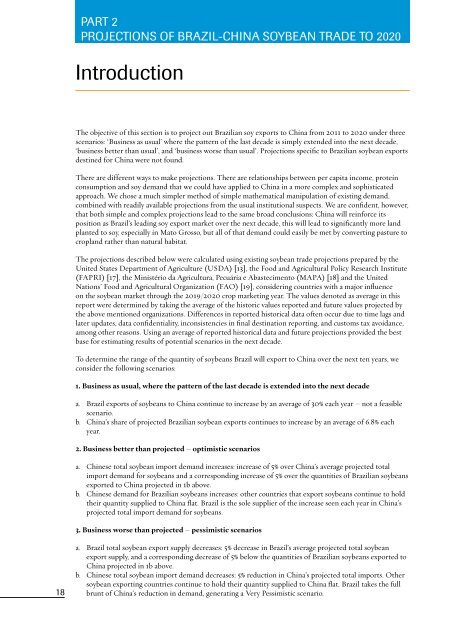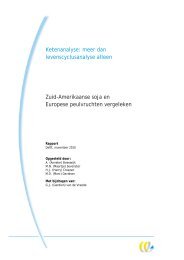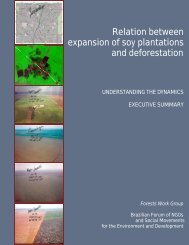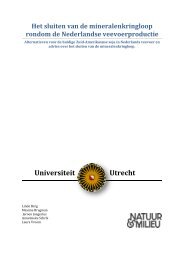Brazil-China Soybean Trade - The Nature Conservancy
Brazil-China Soybean Trade - The Nature Conservancy
Brazil-China Soybean Trade - The Nature Conservancy
Create successful ePaper yourself
Turn your PDF publications into a flip-book with our unique Google optimized e-Paper software.
PART 2PROJECTIONS OF BRAZIL-CHINA SOYBEAN TRADE TO 2020Introduction<strong>The</strong> objective of this section is to project out <strong>Brazil</strong>ian soy exports to <strong>China</strong> from 2011 to 2020 under threescenarios: ‘Business as usual’ where the pattern of the last decade is simply extended into the next decade,‘business better than usual’, and ‘business worse than usual’. Projections specific to <strong>Brazil</strong>ian soybean exportsdestined for <strong>China</strong> were not found.<strong>The</strong>re are different ways to make projections. <strong>The</strong>re are relationships between per capita income, proteinconsumption and soy demand that we could have applied to <strong>China</strong> in a more complex and sophisticatedapproach. We chose a much simpler method of simple mathematical manipulation of existing demand,combined with readily available projections from the usual institutional suspects. We are confident, however,that both simple and complex projections lead to the same broad conclusions: <strong>China</strong> will reinforce itsposition as <strong>Brazil</strong>’s leading soy export market over the next decade, this will lead to significantly more landplanted to soy, especially in Mato Grosso, but all of that demand could easily be met by converting pasture tocropland rather than natural habitat.<strong>The</strong> projections described below were calculated using existing soybean trade projections prepared by theUnited States Department of Agriculture (USDA) [13], the Food and Agricultural Policy Research Institute(FAPRI) [17], the Ministério da Agricultura, Pecuária e Abastecimento (MAPA) [18] and the UnitedNations’ Food and Agricultural Organization (FAO) [19], considering countries with a major influenceon the soybean market through the 2019/2020 crop marketing year. <strong>The</strong> values denoted as average in thisreport were determined by taking the average of the historic values reported and future values projected bythe above mentioned organizations. Differences in reported historical data often occur due to time lags andlater updates, data confidentiality, inconsistencies in final destination reporting, and customs tax avoidance,among other reasons. Using an average of reported historical data and future projections provided the bestbase for estimating results of potential scenarios in the next decade.To determine the range of the quantity of soybeans <strong>Brazil</strong> will export to <strong>China</strong> over the next ten years, weconsider the following scenarios:1. Business as usual, where the pattern of the last decade is extended into the next decadea. <strong>Brazil</strong> exports of soybeans to <strong>China</strong> continue to increase by an average of 30% each year – not a feasiblescenario.b. <strong>China</strong>’s share of projected <strong>Brazil</strong>ian soybean exports continues to increase by an average of 6.8% eachyear.PART 2PROJECTIONS OF BRAZIL-CHINA SOYBEAN TRADE TO 20201. Business As UsualAs outlined in Part 1 of this report, the soy boom of the past decade marked a period of skyrocketingdemand for soybeans and <strong>Brazil</strong> rapidly responded with increased production and exports. From 1998/99to 2008/09, the average annual growth of <strong>Brazil</strong>ian soybean exports to <strong>China</strong> was 57.6%, but this figure isskewed by extraordinary growth in the years 1998/99 and 2000/01, with 213% and 188% growth over theprevious year respectively. It is sounder to use a shorter timeframe that reflects a less volatile trend, so we usethe period for 2005/06 to 2008/09, which has an average annual growth rate of 30% in <strong>Brazil</strong>ian soybeanexports to <strong>China</strong>. Maintaining this growth rate for the next decade is not viable, as exports to <strong>China</strong> wouldsurpass projected total exports by 2011 and even projected total production by the year 2014 (figure 12).Metric Tons, in thousands<strong>Brazil</strong> soybean production and exports - historical and projection dataAssumes <strong>Brazil</strong>ian soybeans exports to <strong>China</strong> maintain current annual rate of increaseat 29.7%, a situation that is not feasible90.00080.00070.00060.00050.00040.00030.00020.00010.000-98/9900/0102/0304/0506/0708/0910/1112/1314/1516/1718/19<strong>Brazil</strong> soybeanproduction average(FAPRI/MAPA/USDA/FAO)<strong>Brazil</strong> soybeansexported to <strong>China</strong>(MAPA)<strong>Brazil</strong> soybeansfor export Average(USDA/FAPRI/MAPA)2. Business better than projected – optimistic scenariosa. Chinese total soybean import demand increases: increase of 5% over <strong>China</strong>’s average projected totalimport demand for soybeans and a corresponding increase of 5% over the quantities of <strong>Brazil</strong>ian soybeansexported to <strong>China</strong> projected in 1b above.b. Chinese demand for <strong>Brazil</strong>ian soybeans increases: other countries that export soybeans continue to holdtheir quantity supplied to <strong>China</strong> flat. <strong>Brazil</strong> is the sole supplier of the increase seen each year in <strong>China</strong>’sprojected total import demand for soybeans.3. Business worse than projected – pessimistic scenariosFigure 12: Demonstrates how maintaining the growth rate of <strong>Brazil</strong> soybean exports to <strong>China</strong> over the pastdecade is not feasible, as it would surpass projections for both <strong>Brazil</strong>’s total soybean exports (2011-2012) aswell as <strong>Brazil</strong>’s total production (2014-2015).Over the period 2005/2006 – 2008/2009, <strong>China</strong>’s share of <strong>Brazil</strong>ian soybean exports steadily increased,with an average growth rate of 6.8%. If we continue that trend outward through 2019/2020, <strong>China</strong> imports83% (32.9 million tons) of <strong>Brazil</strong>’s projected available export stocks by the end of the projection period(figure 13). This is consistent with world USDA and FAPRI soybean trade projections that reveal <strong>China</strong>’ssoybean imports will increase between 41.5 – 43.4% (approximately 18 million tons) over the projectionperiod, while the rest of the world’s imports will increase only 3.9 – 7.3%. In other words, <strong>China</strong>’s increaseddemand will account for over 85% of the nearly 20 million ton increase in soybean trade. To meet thisincreased demand, we note the emergence of other South American countries, particularly Argentina anda. <strong>Brazil</strong> total soybean export supply decreases: 5% decrease in <strong>Brazil</strong>’s average projected total soybeanexport supply, and a corresponding decrease of 5% below the quantities of <strong>Brazil</strong>ian soybeans exported to<strong>China</strong> projected in 1b above.b. Chinese total soybean import demand decreases: 5% reduction in <strong>China</strong>’s projected total imports. Other18soybean exporting countries continue to hold their quantity supplied to <strong>China</strong> flat. <strong>Brazil</strong> takes the fullParaguay, as major players in the export market, but <strong>Brazil</strong> and the US continue their dominance withbrunt of <strong>China</strong>’s reduction in demand, generating a Very Pessimistic scenario.increased exports[13].19












